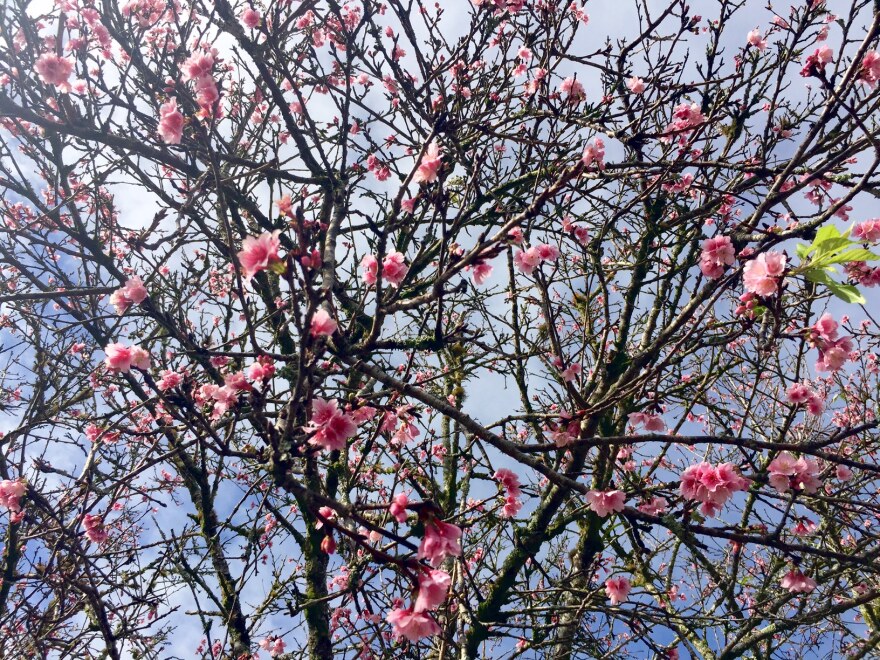
In 1985, Japan’s Prince Hitachi planted the cherry trees fronting Leilehua High School to celebrate the centennial of Japanese immigration to Hawai‘i. He was contributing to the hundreds of sakura that now bloom every spring in Wahiaw? ---depending on the weather. HPR’s Noe Tanigawa found many of the trees trace back to one ancestor from Okinawa via Waipi‘o.
The 29th Annual WNCA Sakura Matsuri is happening in 2017, and it's a two prong event. The first is the "Japanese Musical Extravaganza!" in the Wahiawa Hongwanji YBA Hall – 1067 California Avenue on January 28, 2017 – 7:00 pm. Expect lots of local talent, karaoke, taiko, odori (Japanese dance), treats, and best of all, a sakura tree giveaway!! Plus waffle dogs. This is a fundraiser for the Leilehua High School Japanese Language Class.
Last year, I loved the Sakura Safari or Hanami – a 90-minute trolley tour guided by Wahiawa locals.
Date: February 4, 2017
Time: 9:00 and 11:00 AM, and 1:00 PM
Place: meet at Wahiawa Ryusenji Soto Mission,
164 California Avenue
Cost: $20.00 for trolley ride,
5.00 Sakura Safari Bento” (optional)
RSVP: Rene Mansho – ph: 291-6151
email: renemansho@hawaii.rr.com
Disclaimer: nobody knows from one year to the next, how many flowers there will be or when they will peak. If you go, do not miss the bentos.
Morning sprinkles were just clearing on a back stretch of California Avenue in Wahiaw? when I arrived at Kazue Nursery. Looking upward, thousands of delightful pink sakura, cherry blossoms, were silhouetted against the blue sky. KazueTsujihara’s family grew them.

Many of the hundreds of sakura trees in Wahiaw? trace their ancestry to one tree Choro Nakasone brought from Okinawa. In the mid 1950’s, Nakasone gave a plant to Tsujihara’s father, Tasuke Terao, who began to plant and dream---especially after Wahiaw?’s pineapple image lost its footing.
Indomitable volunteer, Rene Mansho says, at the time of statehood, Wahiaw? was THE pineapple town. Once that industry faded, Nakasone and Terao had the idea to make Wahiaw? a cherry blossom town. According to Mansho, the idea really took hold after Japan’s Prince Hitachi planted those trees in front of Leilehua High School.

For the past 13 years, as part of Wahiaw? Japanese Civic Association activities, Rene Mansho has offered trolley tours of the sakura---a sort of mobile hanami, or cherry blossom viewing. She says Tasuke Terao was always a big community booster, the loudest banzai at Wahiaw? Nikkei Civic Association functions. A retired plumber, he began propagating cherry trees and giving them away to businesses, parks, individuals, anyone who would plant them. They did.
Hanami, cherry blossom viewing, is possible every spring in Wahiaw? because of community effort. On the trolley tour, Mansho hits the back roads and dead ends of the town in search of blooming trees in peoples' back yards, sharing local lore along the way. One year, a storm blew all the flowers off so Mansho just toured the neighborhoods and townies got to visit, for example, Petersen’s egg farm, the famous source of those brown double yolk eggs.
Now people in Hawai‘i Kai, K?ne‘ohe, M?noa, Wai‘anae all want sakura trees, says Mrs. Tsujihara. The problem is, sakura need a cold winter in order to blossom, according to Hirotaka "Jack" Tsujihara, a retired aeronautical engineer, who is now a sakura cultivator. The sakura in Wahiaw? are largely from Okinawa and Taiwan, they are pinker and sturdier than the Japanese blossoms. Mr. Tsujihara says Okinawan sakura need mid forty degree temperatures to really blossom --- and Wahiaw?’s elevation barely suffices.
Mr. Tsujihara says sakura usually lose their leaves in October or November if it’s cold enough, they need to be bare for the sakura to bloom. It’s particularly poetic seeing the twisted, scrawny looking trees with pinky frills.
Luckily, this past December and January were quite chilly, so the sakura are in bloom now.
The Cherry Blossom Trolley rides are just about full. Fee for the trolley ride is $20 apiece, with a $5 bento lunch (which I hear is really worth $12) from Kitchen Delight.
Book your seat on the Hana Mi-Cherry Blossom Trolley by contacting Rene Mansho at (808) 291-6151 or Renemansho@hawaii.rr.com. She recommends calling right after the new year begins.
Unbelievably, Mansho also offers free tours to anyone who can get a group together and provide transportation. The day we spoke, she was meeting a group from 15 Craigside at Dot’s and off they went.

For sakura viewing on your own, try California Avenue, especially past Leilehua High School after the road turns to the right, fronting Kazue Nursery on the right. Kazue and Hirotaka Tsujihara are trying to propagate as many more cherry trees as possible every year. They only manage to produce 20-30 new sakura annually, and ten are given away at the Wahiaw? Nikkei Civic Association Sakura Matsuri which is held every January. Glenn Avenue often offers good viewing also.
Adding to the atmosphere, tomorrow, Saturday at 1:30, UH Professor Darin Miyashiro and his students will give a koto concert at Wahiaw? Public Library.
Sakura or no sakura, go to enjoy Wahiaw?!





